Putting It into Practice[1] : Using Feminist Fractured Foundationalism in Researching Children in the Concentration Camps of the South African War[2]
by Liz Stanley and Sue Wise
University of Edinburgh; University of Lancaster
Sociological Research Online, Volume 11, Issue 1,
<http://www.socresonline.org.uk/11/1/stanley.html>.
Received: 21 Apr 2005 Accepted: 2 Aug 2005 Published: 31 Mar 2006
Abstract
Feminist fractured foundationalism has been developed over a series of collaborative writings as a combined epistemology and methodology, although it has mainly been discussed in epistemological terms. It was operationalised as a methodology in a joint research project in South Africa concerned with investigating two important ways that the experiences of children in the South African War 1899-1902, in particular in the concentration camps established during its commando and 'scorched earth' phase, were represented contemporaneously: in the official records, and in photography. The details of the research and writing process involved are provided around discussion of the nine strategies that compose feminist fractured foundationalism and its strengths and limitations in methodological terms are reviewed.
Keywords: Feminist Fractured Foundationalism, Feminist Methodology, Feminist Epistemology, Feminist Sociology, South African War 1899-1902, Concentration Camps, Children, Retrievable Documents, Photographs
Introduction
1.1 As part of a longstanding collaborative project concerned with feminist methodology and epistemology,[3] we have formulated a framework for a grounded research practice termed 'feminist fractured foundationalism'.[4] In company with others, we have contributed to the development of a feminist sociology (S. Jackson, 1999, 2000), in our case involving rejecting the 'cultural v. material' binary in favour of an approach that includes both.[5] Feminist fractured foundationalism also eschews 'Theory' in favour of what Mary Maynard has called feminist middle order theories (Maynard, 1995) and is concerned with social investigations which will produce what Stevi Jackson (1999: 4.2) refers to as "grounded generalisations… more easily integrated with empirical research".[6]1.2 There is, however, an impasse in much present thinking about feminist social science research (Wise & Stanley, 2005): epistemological discussions have become bogged down in reformulations of abstract debates of a 'realism v. idealism' kind, rather than rethinking the binary; and there has been relatively little attention to new developments in research practice and an over-emphasis on repeated discoveries of gender patterns and inequalities in social life.[7] The development of feminist fractured foundationalism (FFF) has been a direct response to these problems, an attempt to find a constructive resolution by tackling the epistemological division head-on while being as concerned with grounded research practice as with theoretical conceptualisations. As a consequence, FFF was formulated to recognise both the materiality of social life and reality and its socially interpreted and culturally constructed aspects, as well as an epistemological position which rejects the tired old realism/idealism binary as a misconceived simplification. In doing so, we have drawn on longstanding traditions in sociology (including symbolic interactionism, sociological phenomenology and cultural Marxism) that have, in our view sensibly, wanted to 'have it all' and to emphasise that it is not a matter of either/or but rather both when it comes to realism and idealism. Following this, and in keeping with the above discussions by Maynard and Jackson, we became interested in configuring FFF as a methodology to be used in grounded social research practice, rather than it remaining an epistemology to be theoretically elaborated (Wise & Stanley, 2005; Stanley & Wise 2006). It was in this regard that we used the FFF framework in a project conducted in South Africa during 2004, with the focus being how FFF shaped up when used, reviewing its possibilities and limitations in grounded research of the kind we carried out.
1.3 For many academic feminists, feminist research is conceived in specific terms as the empirical and theoretical investigation of a range of topics and issues cohering around notions of sexual difference. A signal difference between this and feminist sociology as we conceive and champion it is that feminist sociology 'wants it all'. Feminist sociology is not a 'specialism', like sociological work on the body or indeed on gender, but is rather a way of rethinking and reconfiguring the whole of the discipline in feminist terms. Consequently the kind of feminist sociology we align ourselves with refuses to 'know its place', the place of sexual difference and 'suitable' topics associated with women and gender. The whole of sociology is its province.
1.4 'Fractured foundationalism' is our characterisation of social life, the fundamental 'it' that sociological researchers grapple with understanding: social life is both founded in a material factual reality and also involves disagreements and disjunctures between people's views of 'the facts'. The term thus recognises both that there is a materially grounded social world that is real in its consequences (foundationalism), and insists that differently-situated groups develop often different views of the realities involved (fractured). For us, the resultant complexities of interpretation have to be responded to in ways that do not position feminist researchers as a priori overriding the understandings of 'the researched', and therefore FFF involves eschewing assumptions of epistemic privilege. However, researchers who reject a normative or realist epistemology (a conventional form of foundationalism), as we do, still need to have a reasoned grounding for their alternative epistemological position. In our view, fractured foundationalism provides such grounding and also recognises social constructionism.
1.5 FFF is organised around making transparent the practices and understandings of feminist sociological research. However, FFF is not a method (a technique for gathering research data) and can be utilised in feminist survey research as much as feminist interviewing, ethnography, and feminist historiography. Neither is it straight-forwardly an epistemology because, although having epistemological underpinnings, it contains broad precepts for operationalising feminist research in practice. It is instead a methodology, a set of procedural strategies which enable conceptualisation, grounded research practices, writing about data, and theorising from these, to be brought together and thought about as a coherent whole. And, in keeping with our earlier comments about feminist sociology, it is a methodology that can be used in investigating any aspect of social life, any and all of sociology's domain concerns, and is certainly not confined to sexual difference topics.
1.6 From the outset we recognised that, other than 'being a woman who is a feminist', there was nothing about FFF that male social scientists could not do or use (Stanley & Wise, 1990, 1992). Nonetheless, when FFF was first formulated in the early 1990s we proposed that few would do so because its emphasis on analytical reflexivity, moral knowledge and use of retrievable data cut across, indeed more strongly challenged, sociological scientism. However, the last decade has witnessed a significant narrative turn in sociology and a renewed sociological interest in notions of reflexivity; and approaches premised around analytical reflexivity, like FFF, have gained greater acceptability as a consequence. FFF is a feminist epistemology and methodology because it involves research carried out by feminist practitioners explicitly putting 'feminism into practice' in their research practices, with FFF organised around a number of principles or strategies which make feminist researchers more accountable, including analytical reflexivity and the use of retrievable data. But at the same time, there is nothing to prevent any interested male sociologist making use of the fractured foundationalist framework and the strategies that compose it, with these strategies being used to structure the following account of our South African research project.
1.7 The immediate backcloth to this research involves the South African War 1899-1902, particularly its 'scorched earth' phase when the British military burned many Boer[8] farms, and women, children and elderly people were removed to camps of tents, situated along railway-lines so that they could be provisioned.[9] Over 4,000 women and 22,000 children died[10] when a succession of major epidemics – particularly measles, diarrhoea, enteritis, typhoid and pneumonia - occurred, spread when people were moved from one concentration camp[11] to another, to be closer to their original homes. These events, together with how they were remembered and used within the development of Afrikaner nationalism and racial segregation in South Africa, have been the subject of Liz's recent research.[12] The other part of the backcloth is formed by Sue's long-standing research and writing on feminist social work, and her interest in social justice regarding the treatment and welfare of children, around rejecting 'adultist' preconceptions of childhood and recognising the grounded nature of children's lives.[13]
1.8 When we decided to 'test' FFF in grounded research practice, these respective sets of interests were pooled in designing a small project focusing on the experiences of children in the concentration camps of the South African War, for two linked reasons. Firstly, children 'bore the brunt' of the war, while adults were not willing to stop fighting without capitulation from the other side.[14] And secondly, previous research has looked at the war and the camps from the perspective of adults, even though the overwhelming majority of those who died were children.[15] Discussion of our camp children project within the FFF framework begins with the research labour process. The project combined working on archival collections of photographs and of organisational records, as outlined below.
Putting it into Practice
(i) The feminist research labour process[16]
FFF proceeds from the fractured ontological nature of social life. Feminism as a politics centres a radical social ethics; for FFF, this necessitates producing feminist knowledge in an open, accountable and defensible way. Doing this starts with the research labour process. In particular, FFF is concerned with analytical processes concerning how knowledge is produced and the claims made for it. For FFF, method in the narrow sense is unimportant and what matters is why and how they are used and for what purpose. FFF is instead concerned with analytical reflexivity and using retrievable data: providing evidence as well as the interpretation based on this means readers can reach their own conclusions.2.1 Britain provoked the South African War (1899-1902) against the two Boer Republics of the Orange Free State and South African Republic and annexed these as the Orange River (ORC) and Transvaal Colonies. The war, however, did not end there. Boer commandos continued fighting; the British 'scorched earth' policy was a response, as was the institution of direct British rule in the former Republics. Our camp children project was designed with two inter-related components, concerned with exploring the two main ways that experiences of children were represented following the removals of Boer people to the concentration camps during the war. One is the official record, the other involves photograph collections.
2.2 The official records were kept by British administrators at local level in the approximately forty Boer concentration camps, and also in the headquarters of each Colony.[17] These were records of an organisational apparatus concerned with maintaining and regulating the 'removed' populations, with accountability ultimately held by the British government in Whitehall, but beneath this by the colony governments[18] and their chief administrators of the camps, and then beneath this by the superintendents or administrators of each individual camp. There are many extant records – 'returns' of information and also summarising registers.[19]
2.3 The first component of our research involved picking one element of these records, in one of the annexed colonies, for detailed investigation: this was the 'minutes' or files of inquiries between the Chief Superintendent of Refugee Camps (SRC), and the superintendents in charge of the Orange River Colony's (ORC) eleven camps. In the SRC archive collection, there are nearly 11,000 such inquiries, some of which are specifically concerned with children's lives, illnesses or deaths.[20] Accountability for the concentration system was grounded in bureaucratic record-keeping and meticulousness in following agreed procedures; and the fullness of the official records, originating in many different local sites, is striking. So too is the emphasis on following laid-down procedures, like those instituted to bring the epidemics under control, with the inquiries indicating that officials could be so concerned with following procedures that they were unable to 'see' the emotional and political impact that these were likely to have on camp inhabitants. In addition, there was a high level of official inquiry and intervention concerning safeguarding the welfare of children:[21] there are many examples of cutting-edge good professional practice, for instance regarding likely cases of infanticide and child maltreatment by children's carers.
2.4 The second component of the research involves our investigation of the archive collections of photographs of the South African War, specifically a sub-set of the concentration camps in one particular collection, that in the Free State Archives Depot.[22] These were taken primarily by professional photographers, who travelled to war locations and routinely visited the camps, selling their photographs to newspapers world-wide, and to British soldiers and Boer commandos and people living in the camps. A minority were taken by people employed in the camps, as administrators, doctors, teachers, nurses and so on, using one of the Kodak/Eastman cameras available from 1898 on. Many of the professionally-taken camp photographs were 'views' and general pictures sold to newspapers or in local shops; others were taken 'to order' and are 'scenes with people' or posed individuals and groups, which would have been bought by camp inhabitants as mementoes or posted to absent relatives on commando.[23]
2.5 There are three main collections of South African War photographs in South Africa holding around 80,000 photographs.[24] The collection held by the Free State Archives Depot in Bloemfontein (VAB) covers the same camps as the SRC records of inquiries and therefore became the focus of our investigation because of this. These photographs throw a different light on the concentration camps from the official records, the inquiries concerning children in particular, because they feature a much wider range of children's presence and activities. This is absolutely not to suggest that the photographs are more 'real' than the official records (or vice versa). But it is to emphasise that the two sources have different origins and purposes, and that the photographs involve camp inhabitants being more active in choosing how they were represented and also in keeping some of these as mementos post-war.
2.6 In what follows, 'retrievable data'[25] are used to tie the discussion as closely as possible to key documents (both written and photographic) that 'stand for' or exemplify wider aspects of our research and interpretations of it, so that readers can evaluate arguments against their own. We do not claim referentiality for these texts, including the photographic ones. They are not directly reflective of 'the real happenings' that gave rise to them, and nor are they the total evidence drawn on. However, providing them shows something of the evidential base being worked from and enables a more informed readerly evaluation of interpretations and conclusions. This claim is returned to and discussed in the last section of the article, where we comment on the FFF process as a whole and our use of retrievable data within it.
(ii) Grounding feminist knowledge
While FFF may advance preferential knowledge-claims on various grounds, it rejects epistemological privilege, proposing that all knowledge-claims should be evaluated on their specific merits. Consequently the knowledge-claims made by FFF should concern specific examples and be grounded in particular evidence and interpretations. And whether the feminist researcher 'knows' in an authoritative sense depends on the sufficiency of evidence for the conclusions drawn, the plausibility of interpretations and conclusions, and the reception by readers.
2.7 We start with some more information about the research process and why the particular inquiries and photographs that were selected were decided upon, beginning with the SRC inquiries. Many of the total set of SRC inquiries cover matters including or of relevance to children, who composed the large majority of the populations of all the camps. However, our interest was in those where children were the specific focus, so we worked through detailed notes on all the SRC inquiries to identify this smaller group, using Liz's previous research on the collection as a basis. Then the inquiry papers for each of the children's inquiries were read in detail (using other SRC records to generate additional information where available[26]), with Table 1 summarising the concerns of these.
| Table 1: SRC inquiries concerned with children | |
| Area of concern | Number |
| Policy & practice regarding orphans[27] | 15 |
| Child mortality issues | 8 |
| Formal inquiries & P-Ms | 7 |
| Specific children in/out camps | 5 |
| Administrative issues & mis-records | 4 |
| Illegitimacy | 3 |
| Children's rations | 2 |
| Miscellaneous | 5 |
| Total | 49 |
These 49 inquiries were examined in detail, including in relation to wider aspects of the war and the camps. From this, seven inquiries were selected, discussion of which would enable covering the broad distribution of inquiries in Table 1.[28] The retrievable data for each is provided in Appendices 1 to 7, and will be referred to in the discussion which follows through hypertext links in the text at appropriate points.
2.8 A similar procedure was adopted regarding the VAB photograph collection, which neither of us had worked on before. The result was identification of 116 concentration camp photographs, in 61 of which children appeared, with classification of them shown in Table 2.
| Table 2: VAB photographs representing children | ||
| Subjects | Numbers | Totals |
| Views | 14 | 14 |
| Adults | 41 | |
| - employees & others | 20 | |
| - camp inhabitants | 12 | |
| - Relief Committee[29] members | 9 | |
| Children | 61 | |
| - posed (formal, informal) | 14 | |
| - playing | 2 | |
| - working | 9 | |
| - school/Sunday school | 3 | |
| - soup distribution[30] | 2 | |
| - 'relief' activities | 12 | |
| - Peace Day[31] | 3 | |
| - sick & hospital | 2 | |
| - views with people, including children | 14 | |
| Total | 116 | 116 |
The decision to use retrievable data meant considerable discussion of the photographs with children in them, including in relationship to the SRC inquiries being worked on. As with the inquiries, photographs were selected to broadly reflect the distribution of subjects across the whole set, resulting in the eight photographs shown in Appendices 8 to 15.[32] These too will be referred to in the discussion which follows through hypertext links.
2.9 Finally, back in the UK and during the initial work on writing up the research, we focused down on three inquiries and three photographs around which to discuss putting FFF into practice, a small enough number we thought at the time to provide readers with specific examples and also the interpretations based on these. However, we rapidly realised this was too many when working within constrained word limits.[33] The result in our very first published account of the research was a decision to focus mainly on one inquiry and one photograph, but still to provide the retrievable data for the more representative group of seven inquiries and eight photographs, enabling readers to place the two cases discussed in a broader context. The inquiry was selected first, on the basis that it raised the widest range of issues. This was the Swart[34] case, with the retrievable data here a letter from Harrismith's superintendent, Arthur Bradley, written on 25 December 1901 to the ORC's Chief Superintendent, Captain Trollope, and is provided as Appendix 3. Then the photograph was selected, to raise some different issues about a different camp. This is a photograph from Kroonstad, provided as Appendix 10. The wider group of retrievable documents are referred to through hyperlinks in the following discussion which direct readers to the original documents, and also notes containing summary interpretations of these. Active readership of these by readers is required in two respects. Firstly, the whole set of retrievable documents provides a broader informational context for readers to locate the Swart case and the Kroonstad photograph in; and so all of these need reading (the inquiries) and looking at (the photographs) in detail. And secondly, the accompanying summarising interpretations of these need to be evaluated against reading the retrievable documents themselves.
(iii) Unalienated knowledge
Bracketing or cancelling out the act of knowing is highly consequential in feminist terms: it renders invisible the indexical properties of knowledge within a false 'universalism', and by denying the labour involved it alienates this as a devalued commodity. Important dimensions of an unalienated feminist knowledge include grounding the feminist researcher and her research as an actual person at work in a concrete setting; recognising that understanding and theorising are material activities which can be accounted for; and linking the 'act of knowing' (research process) with claims about 'what is known' (research product).
2.10 We start with a methodological conundrum. Superintendent Bradley's letter in Appendix 3 provides a retrievable document which sets out many of 'the events' concerning the death of a young girl, Christina Swart, that came under inquiry in late December 1901 and it can be read and understood as a self-contained text. At the same time, the inquiry went from SRC to Colonial Secretary levels and generated two linked inquiries involving 27 individual records and more words than this entire article, and fully understanding any one of these documents would necessarily draw on wider research on the concentration records as well as 'what came after' in the history of South Africa. Some of the inquiries are even more fully documented; and it is also worth noting that even those which are composed solely by the retrievable document provided, such as Superintendent Shutte's letter about purchasing things for the people affected by the marquee burning in Appendix 1, still require such background knowledge to make full interpretive sense of them. Three examples of interpretive work on Bradley's letter requiring this background knowledge are as follows.
2.11 Firstly, it is highly likely that the heart-wrenching death of Christina Swart was the origin of the repeated refrain of 'sick children seemingly routinely torn from of their mothers' arms to die en route to hospital' that appears in the (proto-) nationalist-orchestrated women's testimonies which were published post-war.[35] Secondly, this is absolutely not to deny that what happened to Christina was appalling and inhumane, but instead to emphasise that the fierce political divisions of the war impacted on people's understandings of 'the facts' and the intentions and meanings they ascribed to these, the source of the disputes commented on in Bradley's letter and across all the Swart inquiry documents. It is also important to contemplate what the seven retrievable documents in Appendices 1 to 7 and the photographs in Appendices 8 to 15 demonstrate concerning what has been 'forgotten' from received or canonical knowledge about the South African War concentration camps: the many accidental deaths brought about by parental tiredness or carelessness (see Appendix 1), cases of infanticide and also murders (see Appendices 2 and 4), the presence of large numbers of sometimes powerful men in the camps (see Appendices 2 and 3), internal disputes and differences among officials (see Appendix 5), organisational requirements and reprimands, the detailed recording of black people's lives and deaths and overall presence (see Appendix 6), and the need to 'do something' about orphans along with the political context this was perceived within (see Appendix 7). And thirdly, some of these complexities are brought into sight by reading Bradley's letter from different viewpoints. Thus the dispute 'on the day' involved Superintendent Bradley, doctors Rossiter and Ralston, Christina's mother Martina Johanna Swart, Resident Magistrate Arthur Leary, and also the civil surgeon carrying out the post-mortem, William Beor,[36] with statements of their various positions appearing in the full set of inquiry documents; and we take 'recovering' and attempting to understand the grounding of these disputing viewpoints to be crucial to the FFF labour process.
(iv) The knowing subject
At an epistemological level, FFF involves a double-take on what 'knowledge' consists of: knowledge is what is constituted as such within everyday knowledge practices, and it is also what feminist researchers make of this (and these may conflict, of course). All society members are engaged in such activities, because all of social life revolves around practical knowledge matters. However, while researchers engaged in social inquiry will usually do this in a more structured and formal way, FFF does not see these activities as different in kind from everyday practices. FFF resists seeing people as immersed in the local and unable to discern the wider relations and structures of ruling, and rejects epistemological privilege for feminist research.
2.12 From Superintendent Bradley's letter, it is clear that Trollope, the doctors and the superintendent were all aware of wider 'non-local' issues of different kinds. Similarly, Parry Edwards, as the Orange River Station medical officer, was clearly aware of overlaps but also differences between overlaying, infanticide and murder, in Appendix 2 ; while Major Wilkins – who replaced Captain Trollope as ORC Chief Superintendent in early 1902 - in the adoption inquiry in Appendix 7 has an eye on the legalities as well as on finances and wanting orphans removed from 'the books' where possible. Returning to Bradley's letter, in it Trollope is positioned around notions of accountability within an organisational hierarchy, the doctors as focused narrowly on the epidemics and deaths and their status in this hierarchy, while the superintendent presents himself as concerned with both humanitarian matters and with issues concerning the Swart 'clan'. In addition, Bradley's letter clearly implies that the Swart men were capable of acting as a power bloc in the camp at the present-time (not just concerning the future 'settlement of the colony') and could influence people back into their 'old discontented state', with one of its sub-texts being how the Swart men would react to Christina's death and its possible political reverberations. The 'absent presence' of Klass Saaiman's father in Appendix 2 raises similar questions about the presence and power of men in the Orange River Station camp, too.
2.13 However, while the Swart men are presented as wealthy and influential, there is no document on file providing their actual viewpoint: this is assumed and invoked, but not presented in its own right. By contrast, Mrs Swart was the determined and active agent whose response to her daughter's illness, and then the circumstances of Christina's death, forced the inquiry to happen; and she and others testify under oath about this. Without her insistence that a post-mortem by an independent person should be carried out, this would have remained an unseemly dispute between adults around a dying child, rather than erupting into organisational sight at a high level. Mrs Swart's insistence then required the Resident Magistrate to write a report concerning the post-mortem and the inquest following, at which the key parties all made sworn statements; and in this, the Magistrate went out of his way to punitively conclude that Christina's death was due to 'improper mutrition [sic] and bad treatment by parents' (because Christina's intestines were full of food, whereas typhoid patients had to be starved to have a chance of survival).
2.14 Another factor requiring contemplation here is that Christina's parents failed to report her typhoid for two to three weeks, with what they thought were her best interests at heart.[37] As other filed documentation shows, they had deliberately hidden Christina from the daily 'sick call' carried out by Boer probationer nurses[38] and secretly buried her lethally-infected faeces. Also, while the post-mortem shows that Christina had been fed on solids, her mother's sworn statement mentions feeding liquids but not solid food:[39] it seems Mrs Swart was aware of the strict advice to starve typhoid patients, but her wish to do her best for her daughter had over-ridden this and she thought that the doctors attempt to take Christina to hospital, rather than her feeding solids to her daughter, had killed Christina.
(v) The fractured ontological base
FFF is predicated on the ontological position that social life is inter-subjectively constructed around ideas and practices concerning structures understood as 'social facts' which are external to and constraining upon society members. Social life is at one and the same time experienced as independent of social construction, but is actually constituted by this. Knowledge necessarily has an ontological basis: there is always a knower situated in time and place with others, going about the business of knowing the social world. Because different collectivities of people understand realities and facts from where (geographically, socially, politically) they are situated, everyday fractures of understanding and meaning - reality disjunctures - frequently arise; however, these are negotiated (sometimes successfully, sometimes with remaining disagreements) around the shared premise that there is real meaning, facts and truth – a social reality - to be arrived at.
2.15 There are complications surrounding 'the facts' in the Swart case, something which also comes across concerning Parry Edward's attempt 'to know' about the death of Klass Saaiman in Appendix 2, with his classification of possible causes of death, reasons why he made the post-mortem, and his careful conclusion. Superintendent Bradley's letter conveys that his response to the doctors was a humanitarian one about Christina Swart, echoed in the comment written in an accompanying document by the ORC Governor, that 'undoubtedly the mother is to blame; yet it seems strange that the child would be removed when actually dying'. However, the superintendent had other motives too, for the implication of his remarks (corroborated in other documents) is that he actually intervened because of the importance of Christina's uncles in the camp. Also, while his letter stresses the 'future settlement of the colony' (a political and imperialist reason he perhaps thought would 'go down well' with Trollope and the latter's political superiors), it also indicates that his pressing practical concern was 'managing' the men in the camp and preventing their 'discontent'. In addition, other filed documents show him 'covering his back' by masking the fact that Mrs Swart had reported Christina's sickness to him before the doctors found out about it.
2.16 Further complexity can be added to this 'mixed motives' reading of the superintendent's role by taking the best possible view of why doctors Ralston and Rossiter acted as they did (it is easy to think the worst because of the effects on Christina Swart, but it should be recognised that they were working in an extreme situation). There are various letters and sworn statements from both doctors on file and, among other matters, these propose the superintendent's sympathies had led him to neglect his duties in the extreme medical emergency that Harrismith was experiencing, while the Resident Magistrate, arriving in camp for the post-mortem, put on record that he had witnessed Bradley appeasing another family who were resisting their child ill with typhoid going into hospital. There had been a large rise in the camp's death rate from November on. The doctors also comment that the Swarts had buried Christina's typhoid-infected faeces in the immediate vicinity; not explicitly stated, because for the doctors self-evident, was that consequently the Swarts were likely to have been responsible for part of Harrismith's hugely-increased death rate in December and January, shown with devastating clarity in Table 3.
| Table 3: Harrismith deaths and death rates, May 1901 – March 1902[40] | |||
| Camp Population | Deaths | Death Rates[41] | |
| May 1901 | - | - | - |
| June | 656 | 1 | 18 |
| July | 927 | 3 | 38 |
| August | 1134 | 5 | 52 |
| September | 1304 | 2 | 18 |
| October | 1596 | 5 | 37 |
| November | 1650 | 13 | 94 |
| December | 1623 | 63 | 761 |
| January 1902 | 1470 | 32 | 261 |
| February | 608 | 4 | 79 |
| March | 348 | 1 | 34 |
(vi) Knowers and competing knowledge-claims
The response of FFF to the question of who can be a 'knower' (in the 'having authority' sense) is that this all depends on where people are situated within the relations of ruling[42] and the operations of power/knowledge in particular contexts. Certainly subjugated knowledges can be given greater or even privileged status, as feminism has accorded to the category 'women'. However, while FFF involves re-evaluating the perspectives and knowledges of subjugated and dominant groups, those of particular women or men are not necessarily viewed as preferential or devalued: this will depend on persons and circumstances. FFF considers competing knowledge-claims around the context or situation, the people involved, how 'the facts' are represented, and who sees these as convincing or flawed.
2.17 Reading the full documentation of the Swart inquiry, what comes across is that all the adults involved had good (but different) moral reasons for acting as they did; however, their same actions can also all be seen as morally wrong when looked at from a different angle. The superintendent had good humanitarian reasons for resisting the doctors' decision – but he only acted on his sympathetic response because Christina's uncles were powerful in the camp. The doctors were battling with rampant typhoid and bringing the death rates down – but they wanted to be top dogs in the official hierarchy, despised the peasant medical beliefs of Boer farming people, and forced the removal of Christina even though she was dying. Mrs Swart comes across as a woman of considerable determination and it is impossible not to feel sympathy for both Swart parents in wanting to protect their daughter – but they probably killed dozens of other people in the process, while Christina might have survived had she gone into hospital (political rumour had it that children were deliberately killed in the hospitals, while the actuality is that survival rates in hospitals were many times better than when people stayed in their tents[43]).
2.18 We have found it impossible (and nor do we want) to adjudicate in the Swart case, in the sense of deciding 'who knew' and whose 'the facts' should prevail: we recognise the different viewpoints involved and we agree and disagree with them all and at the same time. And something similar arises concerning Magdalena Saaiman in Orange River Station camp in Appendix 2: for the doctor in the case, Parry Edwards, there was a difference between 'genuine' overlaying and overlaying linked to infanticide, although in practice he knew that no 'charge of criminal intention' would be brought in relation to either. Its challenging complexity is precisely the reason we selected the Swart case from among the range of possibilities: it raises not only the intricacies of moral or ethical positioning, but also the difficulties in getting a firm purchase on 'the facts'. Another example of this is that, while in one sense 'the facts' are very clear concerning Katit's death and her Death Notice in Appendix 6, the moral dispute here arises concerning 'canonical knowledge' about the concentration camps of the South African War, which 'forgot' the presence of black people in all the 'white' camps, and also 'forgot' that the organisational record system applied as fully to black people as to whites. In a sense, the facts in the Swart case are also completely certain; but also it has to be recognised that the disjunctures and disputes arose because what was important for the adults concerned were their competing interpretations of intention and meaning, which rewrote how they understood these facts.[44]
2.19 One of the features of historical research is that in a sense such disputes are "over" now, and so the temptation to take sides is less than in present-time research. That is, there is no possibility here of the researcher 'intervening' other than by suggesting interpretational possibilities. Also, in the South African case, this 'after' involved rapid political control by the Afrikaners and the institution of segregation and then later apartheid. Taking E.P. Thompson's (1963) injunction for historical research to avoid 'the enormous condescension of posterity' seriously, it has to be recognised that the Boer Republics before annexation, then South Africa after Union and Afrikaner political control, were predicated on a highly racialised form of (proto-) nationalism, and the Swarts and many other people like them were a part of this. This is certainly not to deny the sufferings of Boer people during the South African War – but it is to insist that politics greatly impacted on how wartime events were remembered, and to emphasise that politically-motivated interpretations of intention and meaning really did imbricate 'the facts' both during and post-war (Stanley, 2006).
(vii) Moral epistemology
Epistemology always has a 'moral' or ethical dimension: claims to know are made against or over others, not everyone is deemed a competent knower and so on. 'Moral knowledge' is knowledge that is transparent, produced through non-exploitative means, makes defensible knowledge-claims, produces open accounts of 'findings' and conclusions, and is fundamental to FFF. Also FFF involves a feminist, rather than women's, standpoint, organised around ensuring transparent and accountable good practice for feminist social research concerning the activities involved and the knowledge-claims and the written or other knowledge products that result.
2.20 Evidence from other camps where records about where people died – their own tents or hospital - are extant shows that children survived much better in the hospitals.[45] Clearly, there was something else at work that led to powerful fears about the camp hospitals from women like Mrs Swart. Certainly implicit in the Swart case is a 'clash of medical cultures', the peasant one of Boer farming people and the European-educated doctors, nurses and administrators.[46] In addition, even commentators most sympathetic to the Boer cause and way of life, like Emily Hobhouse,[47] noted the preoccupation with fatty meat and fat in other forms, with rations of lean meat interpreted as deliberate starvation. Alongside this, the standard contemporary treatment for typhoid and all forms of diarrhoea was no food at all. Rations of lower-fat meat, and starvation as standard medical treatment of diarrhoea conditions, underpinned the fears of even well-off farming people like the Swarts that the intention was to starve them to death, so that like Mrs Swart they resisted hospitalisation for what seemed good knowledge-based reasons.
2.21 Does considering 'moral knowledge' in a more direct sense add to comprehension of the Swart case? This might, for instance, involve exploring more about Mrs Swart's agentic and precipitating role in events, by looking closer at how she appears in the range of inquiry documents, and also exploring other SRC records for Harrismith to find further information about her.[48] And a somewhat different take on moral knowledge in this project concerns our determination not to repeat the 'forgetting' of black people that marks canonical knowledge about the South African War concentration camps, and thus our determination to include in our inquiry selections Katit's death notice in Appendix 6, and also the photograph of the smiling young girl in Appendix 11.
2.22 However, FFF is a political and analytical position, rather than a representation of the world according to women, and we are interested in the dimensions of 'moral knowledge' around the most vulnerable and least powerful person involved: the dying Christina Swart, who appears in the inquiry documents only in extremis, with other children in extremis in the retrievable documents being Jacob du Preez (Appendix 1), Klass Saaiman (Appendix 2) and the baby daughter of Miss De Klerk (Appendix 4), for none of them have or can be provided with a narrative voice within the confines of the existing documents and existing ideas of what 'narrative' is composed by.[49] Christina is a cipher in the Swart inquiry documents, an 'absent presence' at the heart of events - that is, she appears only insofar as adults, particularly her parents, attribute feelings and motives to her and not 'in her own right', a clear case of 'adultism'.[50] So, might it be possible to read the inquiry documents to bring Christina into view? We concluded it was not and that this requires consideration of other situations where children became the focus to understand more of the dynamics at work.
2.23 A less fully-documented but more notorious case of a child whose death was disputed between adults exists and involves Lizzie van Zyl, a young girl from Bloemfontein camp. There is a much re-published photograph of a skeletal Lizzie, with her appearance almost automatically assumed to 'show starvation' by adults on all sides.[51] Initially, her mother removed her from hospital following typhoid, because of the starvation diet she was placed on. Then people in neighbouring tents suspected that none of the food visibly present in her family tent was being given to Lizzie. And once the photograph was sent by Hobhouse to the international press, 'the British' were blamed for starving Lizzie, while the British response claimed that she had come into the camp looking as she did and her mother must be responsible. Thus Lizzie van Zyl's illness and death became caught up in a two-sided propaganda battle, as well as occasioning major disputes about 'the facts' during the events of her long illness and then death in Bloemfontein camp itself.
2.24 Like Christina Swart, Lizzie van Zyl has 'vanished' in these disputes between adults, except that her pitiful photograph remains (and is still used, in both main senses of the word).[52] Even when children were the focus, we conclude this was still overwhelmingly as they were seen and positioned (and 'voiced') by adults. Across the entirety of the concentration records, there are very few exceptions to this. One partial exception involves official records in which the clerks or other adults concerned have written things on behalf of orphaned children. The other exception is equally but differently problematic and is provided by a collection of reminiscences by elderly adults of their experiences as kampkinders, camp children, testimonies which were solicited, edited and published, as well as told, through a nationalist political lens some seventy years after the event.[53]
(viii) Analytical reflexivity
The knowledge practices and products of FFF reflect a specifically feminist politics and ethics, with analytical reflexivity key to ensuring transparency and accountability. Analytical reflexivity focuses on the acts of knowing and what goes into this, looking in detail at the analytical processes involved and the evidences supporting these. Analytical reflexivity also entails writing an open research text that: adduces evidence in retrievable form that is appropriate and sufficient for the argument being made and it provides sufficient detail for readers to be able to make their own interpretations and so evaluate conclusions and claims.
2.25 Unless the focus of a research project is based entirely on retrievable documentary sources, it is really not possible to provide readers with all of the relevant evidence.[54] Even a small and limited archive project such as ours, and even focusing on just one case within it as we have done, generates more documentation than can be made available; and anyway many of its arguments and interpretations depend upon knowledge gained from a wider research context, as we have repeatedly commented. It is therefore useful to explore the process of 'knowing' around an archive source which we know no more about than readers. This is a photograph which archive information states was taken in Kroonstad camp and is provided in Appendix 10.[55] Our research project combined researching all three of the main archival collections of photographs from the South African War as well as the concentration camp written records, and an earlier version of this article discussed a group of photographs selected by similar means to the inquiries we have focused on. However, because of space reasons, we have abandoned discussing all of these at equal length, although we have provided all the initially selected photographs as appendices to which our discussion of the particular photograph selected is hypertext-linked at appropriate points.
2.26 As a letter written by a young woman, Lottie Roussouw, to her friend Lottie Theron in Harrismith camp, suggests, professional photographers visited and photographed the inhabitants of Kroonstad camp:
"Thank you too for going to send us the photo you mention. Having ourselves taken in 'Camp Style' is a great wish of mine, but owing to shortness of cash I do not like to plague ^Papa^.[56] If I had a small income of my own I would think the money well spent."[57]Lottie Roussouw's letter to Lottie Theron links Harrismith, the camp the Swarts were living in, with the very different Kroonstad camp. This was much bigger and had many extremely poor Boer people living in it;[58] consequently, using a retrievable document concerning Kroonstad provides a means of recognising the experiences of Boer people living very differently from the Swarts (and see the photograph in Appendix 14, showing a family of comparable status to the Roussouws and the Swarts, and also those in Appendixes 13 and 15, featuring people like most of Kroonstad's inhabitants).
2.27 The mundane content of this photograph from Kroonstad (Appendix 10) - distributing wood and people queuing for this[59] - provides a direct contrast to the dramatic and upsetting events of the Swart inquiry and enables some of the more everyday and routine aspects of camp life to be – literally – seen. We start with what can be seen when looking closely at this photograph; then consider some of the things not actually 'in it' but which can be 'seen' when it is looked at with knowledge of the wider context.
2.28 Amongst other things, this Kroonstad photograph illustrates the orderliness and routinisation which characterised much, indeed most, of camp life. Many of the 'views with people' across the three archive collections are of this kind and suggest, firstly, that 'ordinary life' continued, because cooking, eating and, in South Africa's extremes of weather, keeping warm and dry, remained priority activities; and secondly, that concentration introduced new levels of regulation (e.g. rationing food and firewood) and routinisation (e.g. organising set times and places for their distribution) to ensure this.[60] Also like other 'views with people' in the collections, this photograph witnesses the significant presence of able-bodied men, whereas received wisdom is that the camps were composed of women and children and very elderly people, with all Boer men supposedly loyalists on commando. It also shows the highly gendered division of labour at an everyday level - men and older boys in the foreground are sorting and apportioning the firewood, while women, girls and younger children in the background are queuing and waiting to be given the appropriate ration.
2.29 This Kroonstad photograph was taken by a professional photographer who would have sold the image on – a printed caption appears at the bottom, as does its number in a sequence. It is a 'new photograph', in the sense that its subject departs significantly from both studio portraiture and the more usual 'views' without people on sale in this period…. And it was taken for sale to people, in South Africa and elsewhere, wanting informative photographs showing 'what was going on' in the war and the camps (indeed, apart from the photograph of the Venter children in Appendix 8, all the photographs in the Appendices come under this heading). Other archived photographs in this particular Kroonstad sequence are also 'views with people', including more firewood distribution photographs, the camp mortuary with coffins outside, and burning infected cattle in an area close to the camp, with both the latter being 'sensitive' subjects because raised as part of contemporary criticisms of conditions in this camp.[61]
2.30 There are two further matters worth commenting on, neither 'there' in the photograph itself but important to interpreting it. The first concerns the women and children standing in line and queuing. This of course can be seen - but what is not visible is what this meant for the camp inhabitants. Queuing was a raced activity in the Boer Republics, with such 'lowly' tasks done by black people, not whites, and was a highly resented aspect of life in all the camps because it indicated Boers not being treated as 'superior' in race terms. Queuing was understood as part of the inexplicable and unforgivable 'topsy-turvy' features of the war in overturning the assumed natural order, with other resonant examples of this being the children fetching water in Appendix 9, Boer women washing clothes in Appendix 11, and cooking and cleaning in Appendix 15.
2.31 The second is what this and other photographs by professional photographers indicate about the openness of the camps to people from 'outside'. As noted above, many 'sensitive' subjects were photographed. However, there is little sense that photographing in the camps was subject to any very stringent controls. Thus, looking at photographs in this Kroonstad sequence (some of which are numbered), it is clear the photographer in question was walking about the camp, taking photographs as different activities and 'scenes' met his eye (all the known professional photographers who worked in the ORC camps were male). The travelling photographers would have needed permission from the camp superintendent to carry out their activities. However, many of them would have been English-speakers, perhaps the source of their 'freedom to roam', as well as of the averted gaze of the little girl shown in Appendix 9. And the photographers were by no means the only visitors: most camps were routinely visited by journalists, 'do-gooders' from abroad, shop-keepers and peddlers, as well as members of the local Relief Committees noted earlier.
2.32 The photographs we have alluded to, the mundane everyday activity of queuing for firewood in Kroonstad and the equally mundane photographs from the other camps, and also our research on the wider number from which these were selected, are absolutely not to be seen as optional extras to our research on the concentration camp records. Inevitably, given their part in establishing and confirming bureaucratic and governmental notions of responsibility and accountability, the written organisational records focus on specific areas of camp life – population size and turn-over in relation to rations-provision, illnesses and hospital attendances, deaths and burials, school attendances and similar matters. Equally so, the extant photographs bear the marks of their ad hoc origins and equally ad hoc survival in the post-war period and concern a diverse array of subjects, from views to persons to peak events like sports days and confirmation classes and including deaths and burials in the camp cemeteries. Each throws interesting and important light upon the others and both are needed to gain some perspective on 'what it was like'.
In Conclusion - A Modest 'Internalist' Approach to Feminist Knowledge Production[62]
While many feminist approaches see the grounding for feminist knowledge-claims as possession of 'the facts', indeed better or best facts, for FFF the grounding lies in 'moral knowledge', that is, accountable knowledge produced by the 'knowing subject'. Rather than macro-level societal change 'out there' and how to change oppressive circumstances by producing better or hegemonic feminist facts, which is the 'externalist' concern of much feminist research, FFF has a modest 'internalist' concern with academic feminism's prime task of crafting knowledge in a feminist form.3.1 Operationalising the FFF framework has made us think very carefully about the 'how' of presenting our camp children project for an audience. That is, its exposition had to be provided within the structure of the terms set by this framework, so that readers are able to assess what is written about against the strategic components of FFF. Having readers in mind in this way certainly provided a powerful incentive to make what we were doing as accountable as possible. As part of this, we were very methodical about the selections of inquiries and photographs made and how these would 'fit' the specifications of the FFF framework, and in fact changed these selections many times as a consequence. In relation to these various matters, we concluded that FFF was useful to think with, promoted a structured and methodical set of working practices, encouraged accountability and constrained carefulness in fulfilling the requirements of the framework.
3.2 However, as we have operationalised it (and we recognise there are other ways of doing so), the FFF framework shapes up most powerfully as a way of rethinking who and what the feminist social research process is concerned with representing. We are interested in FFF as a means of bringing into focus the most vulnerable and least powerful, and in the project reported on here this is children rather than women. One of the consequences of knowing 'what came after' in the South African case is that it becomes difficult, indeed impossible, to see Boer women as straight-forwardly heroines or victims; and it was children who bore the brunt of politically and morally objectionable conduct by adults, women as well as men, on both sides. This focus on children was a very powerful aspect of the process and one we welcomed – it certainly made us very aware of 'adultism' both in the contemporary documents (including the photographic sources, although to a perhaps lesser extent than written documentation) and in the assumptions and focuses of researchers, ourselves included.
3.3 Using the FFF framework with its emphasis on the multifaceted character of social life made us closely attend to reality-claims and to the complexities, fractures and disjunctures that surround these. It is one thing to say that social life is both materially-grounded and socially constructed. It is quite another to grasp the nettle of this; and working within the FFF framework really did enable us to discern how complicated reality issues and truth-claims were, even within the context of their representation in the organisational documents we were working with. In addition, this emphasis on fractures and disjunctures, as well as 'the facts' that produced and succeeded these, was coupled with analytical reflexivity and an attention to providing details of the whys and wherefores of the interpretations and conclusions we wanted to make. Again, these are all things we welcomed about our experience of putting FFF into practice.
3.4 It has been put to us that we present this research as an intellectual/moral/political endeavour, while it ought to be presented as an intellectual/moral/emotional/political one and that we should reflect on our emotional engagement with the research process and the relationship between this engagement and the product of the research. Certainly we have no objections to and much support for doing this where relevant and appropriate. Indeed, we first argued this about emotion as a component of all social research over twenty-five years ago (Stanley & Wise 1979) and have consistently supported this position ever since. However, the key words are 'where relevant and appropriate', and we do not accept that either apply with regard to this specific research at this particular stage in what has been a long engagement with the South African War for one of us (Liz) and a much longer engagement with unnecessary child deaths for the other (Sue).[63] That is, close familiarity, and also time and its passing, both take the edge off what would be for newcomers and in relation to present-day child deaths a much more emotional experience. Under such circumstances, the analytical dimensions of emotion certainly should be included within research writing when putting FFF into practice – but we must stress analytical dimensions here, not just wallowing or describing emotion for the sake of moral credentialism. This is not to say that neither of us had no emotional responses to the specific details of what we were researching; but it is to emphasise that these were very much background to the analytic tasks in hand, and this account of the research is concerned with presenting the process and product of these.
3.5Before moving on to discuss some of the other issues that arise, we want to comment about ethical issues in relation to what has become the now usual, indeed almost obligatory, social science practice of anonymising 'subjects' (regardless of whether these people want anonymity or not). Regarding our research, state and nationalist commemoration of the concentration camps and their dead have ensured that the names of the people who died are present in public places across South Africa. These names are 'there', typically inscribed onto huge blocks of marble, across the concentration begraafsplase (cemeteries) and Gedenktuine (Gardens of Remembrance) and are a matter of emphatic public statement as well as of public record. In addition, over a now lengthy period of time Afrikaner historians have published translated compilations of 'official records' from a range of the camps, and more recently some books of photographs have been published, with the result that the names of people who lived and died in the camps are present in widely available publications. Indeed, it is not too strong a statement to say that the 'point' of commemoration has been to ensure that all these names do indeed have public presence. Consequently, the research we have done, separately and together, about the concentration camps of the South African War has had to take this public visibility into account, and not least so as respect the insistent wish not 'to forget' the specific lives and deaths of the people concerned.[64] The result is that, contrary to standard practice, we have necessarily retained the actual names of the people we discuss. Christine Swart's name along with the names of many of the people we have mentioned in this article are publicly present in commemorative space and place, so changing the names present in archival documents would not only 'offend' the wish for public visibility, but also make it impossible for other researchers to explore the complex and important relationship between the archival record and the commemorative one.
3.6 The doctoral research process requires the basis of knowledge and the methodological and other competences underpinning this to be fully demonstrated - having to be accountable about such matters because they will be interrogated as part of the oral examination of the eventuating thesis. However, it is salutary to note that, the more experienced researchers are, the more readers are expected to take research and writing practices on trust and to bracket many of the things that 'expert readers' (like PhD thesis examiners) would expect to be fully accounted for. Therefore another useful feature of the FFF framework is that it requires researchers to be more fully accountable for our research practices because of having to demonstrate the basis of knowledge-claims made.
3.7 One aspect of this that deserves separate mention concerns readers. We see FFF as a process concerned with accountability as part of evening up the ordinarily sharp power imbalances between writers and readers, in which readers are given knowledge products, the production of which they are required to take on trust. FFF provides something - albeit not all - of the research and knowledge-production process. In addition, knowing that readers can read at least some of the same documents as we means that readers are kept in mind throughout the processes of operationalising FFF and definitely made us attentive to what readers would need to know in order to actively read the retrievable documents we selected. It also led us to find ways of weaning readers away from the usual 'take it on trust, or reject it out of hand' way of reading academic work, to find ways of constraining readers to be active and inquiring and to think precisely about what they are reading. While FFF requires active and accountable writing, it also requires active reading. Moral epistemology cuts both ways.
3.8 However, there were also times when we experienced the FFF framework as imposing constraints and inflexible boundaries, rather than providing a flexible means of reporting on a process. Operationalising FFF considerably shaped what and how we wrote about what we have, so much so that at the end of the process we were – and still are - left wondering whether the most important things about the research had been written about or not. The Introduction commented that FFF is a means of producing middle range 'grounded generalisation' that are integrated with empirical research. In a sense, this is so; but the kind of generalisations involved are most definitely shaped and organised in ways they would not otherwise have taken, while other possibilities lie outside of FFF concerns and never come into analytical sight. However, while recognising this, we do not wish to lose sight of the fact that this also brought with it some important analytical gains, as already noted.
3.9 At the end of the process, we concluded that using the FFF approach certainly evens up things for the reader, particularly by providing retrievable data and endeavouring to work this in analytically reflexive ways, and we are interested in how present readers understand this and see its pros and cons. It does so by putting the spotlight on the researcher and their research practices and making researchers be much more accountable. However, does it do this at the expense of sidelining attention to the analysis of the research data? Certainly using FFF made us contemplate and write about things we would not have ordinarily done. With regard to children and the 'narratively dispossessed' more generally, we think this has been worth the constraints involved. But we are also aware there are important aspects of both the inquiries and the photographs that have not even been mentioned in passing and regret this. So is it simply a matter of gaining on the swings but losing on the roundabouts? For us, 'the jury is still out' here.
3.10 There are also issues concerning the use of retrievable data within the FFF framework. Initially we thought there was a problem in using retrievable data, that this was suitable only for discussing technical matters which are entirely recoverable from within a single document or other data source. In contrast to this, all the time we felt the need to adduce wider knowledge to understand what was readable or observable 'in' these written and visual documents. However, further reflection suggested that the problem is actually much more simple and concerns word constraints. That is, it would be relatively easy to write a book around a collection of retrievable data, in relation to which readers really would be active agents with regard to the researcher's arguments and interpretations. But in the short length of an article or chapter, it is necessary to explain the background because it is not possible to provide a succession of retrievable documents around which explication of their contents would supply such background information. At the same time, it is worth making a caveat here. Having initially considered that there are special requirements in this respect concerning historical research, dealing as it does with the 'long ago and far away', and that research on the shared 'here and now' could trade on common knowledge, we now think it is mistaken to assume that 'everyone knows', not least because potential readers come from many different cultures and different parts of the world. That is, we think exactly the same issues arise with using present-day documents, and that assumptions of 'common' knowledge actually ignore the fact that many or even most readers will not share this.
3.11 Finally, we know that a variety of people in a range of projects – in China, Australia, Canada and Eastern Europe - have used the FFF framework in their own grounded research practices. We would be interested in hearing about their and other people's experiences of doing so, and what kind of conclusions they have come to. We are also curious about how people respond to and make use of the ideas we have put forward in this present discussion, and we look forward to commentary and debate on this.
Notes
1 Many thanks to the three anonymous referees who provided helpful comments.2 Our sincere gratitude to the always helpful and knowledgeable staff of the Free State Archives Depot, one of our world-favourite places to carry out research. The transcribed documents and photographs in Appendices 1 to 14 appear with the kind permission of the Free State Archives Depot, Bloemfontein, South Africa.
3 Including Stanley & Wise, 1979, 1983a, 1983b, 1990, 1992, 1993, 2000.
4 Including Stanley & Wise, 1993, 2000; Wise & Stanley, 2003, 2005.
5 We are persuaded of the importance of 'words' (and texts) and reject a denuded concept of 'things', thinking about this within a feminist sociological rather than a cultural studies framework.
6 As argued in Wise & Stanley, 2003.
7 This is certainly not to suggest that uncovering and pinpointing inequalities is unimportant – the emphasis in our comment is on what is 'repeated', on confirming things already well-known.
8 Literally, farmer; by the 1890s these people, later known as Afrikaners, also included an urban educated class.
9 Useful reading includes Cuthbertson et al, 2002; Hanekom & Wessels, 2000; T. Jackson, 1999; Nasson 1999; Pretorius 2001; Spies 1977.
10 Post-war, information about male death rates in the camps was in effect suppressed, because of the political mythology that all Boer men were loyalists on commando.
11 Although now it is almost impossible not to read the term through knowledge of the Nazi work and death camps, it is important to keep in mind, firstly, that the term had no such meanings at the time; and, secondly, that Goebbels deliberately labelled the Nazi camps as he did as part of anti-British propaganda, of a 'they had concentration camps too, how dare they criticise us for having them' kind.
12 See Stanley, 2002a, 2002b, 2002c, 2004, 2005a, 2005b, 2006; Stanley & Dampier, 2005; Dampier & Stanley, 2005.
13 See Wise 1990, 1991, 1995, 1999.
14 This applied to women too: indeed, contemporaries saw Boer women as more militant than their menfolk; 'The Brunt of the War and Where It Fell' is the title of a 1902-published book by Emily Hobhouse.
15 Interesting reading which departs from the usual 'adultist' concerns with childhood includes all the contributions to Christensen & James, 2000; also Ferguson, 2004, James & Prout, 1990; James et al, 1998; Qvortrup et al, 1994; Strange, 2002.
16 Here we use the titles and descriptions of the nine strategies composing FFF as they were originally formulated; obviously male sociologists wanting to put FFF into practice will need to reformulate them as appropriate. The descriptions starting each sub-section are summaries from previous more detailed discussions.
17 Some were informal while others were started but then moved, so tracking the exact number is complicated, not least because some records were lost en route to being archived post-war. The key collections are the Director of Burgher Camps Collection, Transvaal Archives Depot, Pretoria; and Superintendent of Burgher Camps Collection, Free State Archives Depot, Bloemfontein; both are in South Africa. Helpful reading on imperial and other archives includes: Bartel, 1996; Cohn, 1990, 1996; Crais, 2002; McEwan, 2003; Richards, 1993; Rose, 2000; Starn, 2002.
18 Following annexation, these were mixed military and civil governments.
19 These concern sicknesses and deaths, rations distribution, supplies arriving, people (often black) employed to provide services needed to run the camps, passes to work in local towns or visit husbands at the front, the array of goods for sale in camp shops, camp schools, and more.
20 We could have also included Transvaal inquiries, of which there are a number of interesting examples, but excluded these because of word length considerations.
21 The camp populations were indeed concentrated ones, making things visible that would not have been in ordinary circumstances, and there were many newly-trained professionals working in wartime South Africa. For informative accounts of child welfare practices in the UK, where many of the personnel came from, see Ferguson, 2004 and Hendrick, 1994.
22 Relevant reading on using photographs includes Banks, 2001; Brink, 2000; Bugin, 1982; Chaplin, 2005; Paris, 2003; Pols, 2002; Riches & Dawson, 1998; Rose, 2000, 2001; Sontag, 1977, 2003; Walker & Moulton, 1989.
23 A postal service was maintained by both sides and with traffic in both directions, albeit involving censorship.
24 These are: Fotosversameling, Transvaal Archives Depot, Pretoria; Fotosversameling, Free State Archives Depot, Bloemfontein; Fotosversameling, War Museum of the Boer Republics, Bloemfontein; all in South Africa.
25 By which we mean the provision of a transcript of an original (in this case written or photographic) document.
26 Some records were lost en route to being archived post-war.
27 The majority of the inquiries about orphans date from after peace was declared, on 1 June 1902.
28 In relation to Table 1, these are: one inquiry concerning adoption of an orphan, one concerning mortality rates, two formal inquiries regarding suspected unlawful killings, one administrative inquiry about mis-recording, one regarding non-routine events and expenditure, and one inquiry around a major dispute – the Swart inquiry - which enables many of these concerns and also important issues for FFF to be raised.
29 As this camp was close to the town, a local Relief Committee played a high-profile role in organising funding for and the distribution of 'extras' to rations.
30 This was done by camp authorities, concerned that the individualised approach to cooking and eating in most camps led to many children being inadequately fed.
31 Celebrations were held in all camps after peace was declared on 1 June 1902.
32 In relation to Table 2, these are a posed group, doing domestic chores, distributing firewood, a young African servant washing clothes, inside a camp school, soup distribution, a wealthy family group, and a 'view with people'.
33 See Stanley, & Wise, 2006; this is a commentary on the conclusions of the research, rather than an engagement with the process, which is what we are concerned with providing here.
34 The name appears variously, mainly as Swartz, but was actually Swart.
35 This frequently involved 'working up' a specific event as though something general, indeed ubiquitous. For detailed discussions, see Stanley, 2002a; Stanley & Wise, 2006; Dampier, 2005a, 2005b; Dampier & Stanley, 2005.
36 Beor had in fact been the camp MO before Dr Rossiter arrived.
37 As happened with either the De Klerk family concealing Miss de Klerk's pregnancy, or perhaps just Miss De Klerk herself concealing it.
38 Actually, more akin to health visitors.
39 Including chalk (for the severe diarrhoea involved), brandy and water, and also dog's blood, the latter given to Christina and other people who died from typhoid by a Mrs Fourie.
40 From Hobhouse, 1902: pp.341-4; the information is taken from the UK Government 'Blue Books' or Command Reports.
41 These death rates are per 1,000 population and are annual rates: if deaths continued at this level, in the course of a year 761 people out of each 1000 would die. In some camps death rates at the peak of the epidemics were extremely high, and in Kroonstad (referred to later) reached over 1100 per 1000 per annum.
42 Here we are indebted to the work of Dorothy Smith; see Smith 1974, 1987, 1990a, 1990b, 1999, 2005.
43 See Stanley, 2006, Chapter Six.
44 A different version of this arises concerning the tent burning and death of Jacobus Du Preez in Appendix 1: the disjunctures here are between what is in Schutte's letter and his evident concern for 'the sufferers', with no mention of reprimand for such a serious order having not been followed with such terrible result, and received or canonical knowledge which states as certain fact that all British administrators were officious brutes. What is interesting regarding Griet making her mark in Appendix 7 is that there is the absence of any dispute regarding her authority to do so, indeed rather the reverse: she was asked or required to sign, even though there was no organisational requirement for this.
45 See Stanley, 2006, Chapters Six and Seven.
46 See Van Heyningen, 1999, 2001. Research has, however, avoided more ethically 'awkward' matters such as infanticide (as possibly in Appendix 2) and certainly concerning Miss De Klerk in Appendix 4).
47 Relevant publications are Hobhouse, 1901, 1902, 1923, 1927.
48 Doing this, due to gaps in the extant registers and returns we found only basic information about her household and those of the other Swarts in Harrismith, including Christina's five uncles, who were indeed demonstrably wealthy men. It is also instructive to do this regarding Mrs Du Preez in Appendix 1) for her own death from pneumonia followed these events within two weeks and it is possible that she too suffered burns.
49 On the 'narratively dispossessed' and methodological strategies for circumventing this, see Baldwin, 2005.
50 For an interesting discussion of how children are denied their own 'voice' in the making of history, see Hendrick, 2000.
51 Such children were a considerable moral as well as epidemiological problem: why did they 'fade away' and who was responsible? The basic problem was probably the ubiquitous prevalence of enteritis, dysentery and other diseases involving diarrhoea, noted by some medical officers including in the black camps immediately after civil control was instituted in late February 1901.
52 This is why we resisted using this as one of our selected cases and why her photograph is not used here. That is, the photograph, and through it Lizzie van Zyl's sad death, has been co-opted onto different sides in propaganda battles and in battles over knowledge-claims over the last hundred years.
54 Use of retrievable data was pioneered by conversational analysis, focusing on technical matters concerning the structural aspects of transcribed talk and written documents, with content mainly a background matter. We are interested in using it in contexts where content is of the essence, thus the problem.
55 More detailed discussions of our research on the photograph collections are in progress. Elizabeth Chaplin's (2005) interesting discussion of analysing photographs makes a distinction between photographic realism or using captions and other information in a social constructionist way. As the following discussion indicates, a photographic realist take on them requires researchers to have entirely 'empty heads' and in practice tacit background knowledge is repeatedly drawn on even in 'describing' basic things 'in' this and the other photographs.
56 The ^word^ symbols indicate a word that the original writer added to the sentence.
57 Lottie Roussouw, Kroonstad, to Lottie Theron, Harrismith, 7 May 1902; War Museum of the Boer Republics, Bloemfontein, 6344/59. Lottie Roussouw's mother Johanna in 1903 wrote a testimony published later in Hobhouse 1927; Johanna was keenly republican and involved in women's proto-nationalist networks, while Mr Roussouw was a Free State official of considerable means and while in camp the family employed a number of servants.
58 As Lottie Russouw complained to her friend. It also had a phenomenally high death rate (from measles in particular) from June 1901 to January 1902, reaching 1173 per thousand per annum in August 1901.
59 We note that even 'describing' this much about the photograph actually trades on tacit knowledge about the organisation of the camps, how cooking was arranged, and ways of distributing rations.
60 Shown also in the photographs of soup distribution in Appendix 13, a camp school in Appendix 12, and cooking in Appendix 15.
61 See here the reports on Kronstad following visits from the 'Ladies Committee of Inquiry, the so-called Ladies Commission; see Command 893 (1902).
62 'A modest 'internalist' approach to feminist knowledge production' is one of the nine strategies that compose FFF; it is usefully drawn on to overview the FFF process.
63 For a detailed engagement with the complex analytical dimensions of emotion around notions of vengeance and the mis/representation of the past in relation to the South African War concentration camp deaths, see Stanley, 2006.
64 And relatedly, African people were 'forgotten' during this commemorative process – they were 'vanished'; their lives, their names, removed from visible existence. So here there was an important ethical concern to ensure that the lives and names of these people, the repressed and oppressed, 'returned' to a respectful acknowledgement whenever we wrote about them.
Appendices

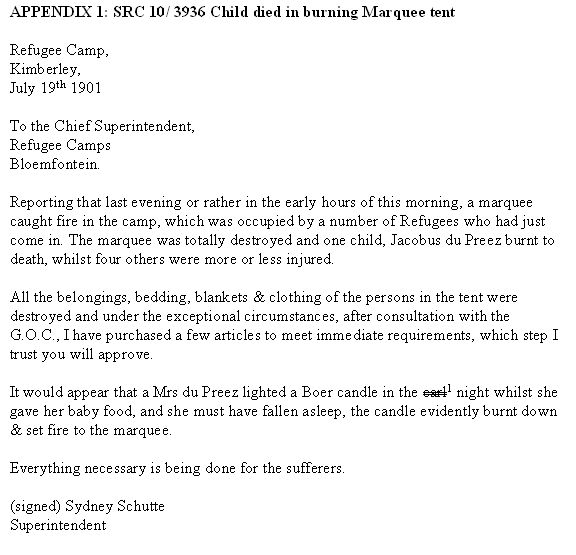 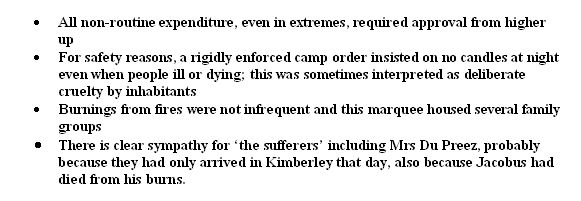
|
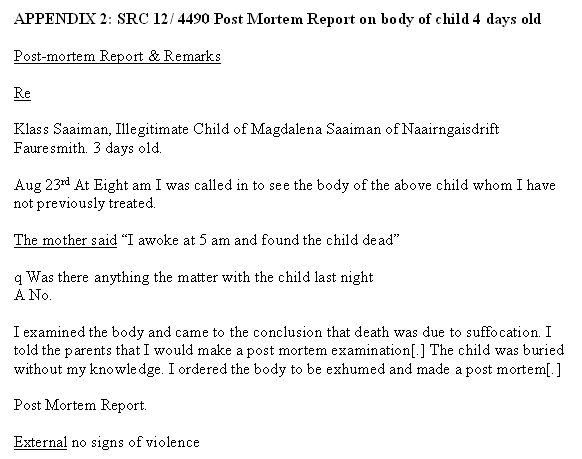 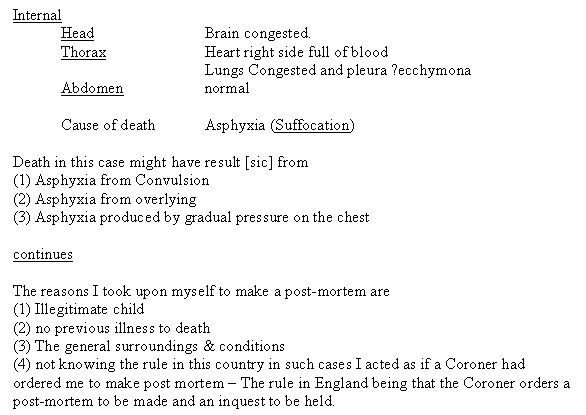 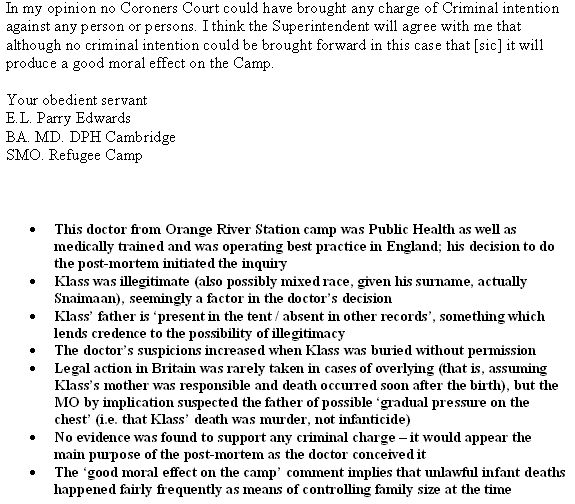
|
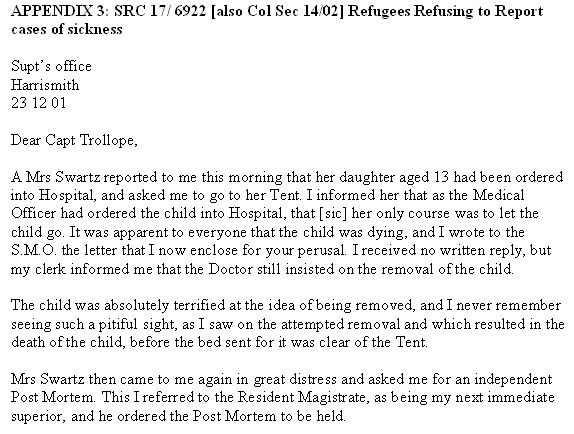 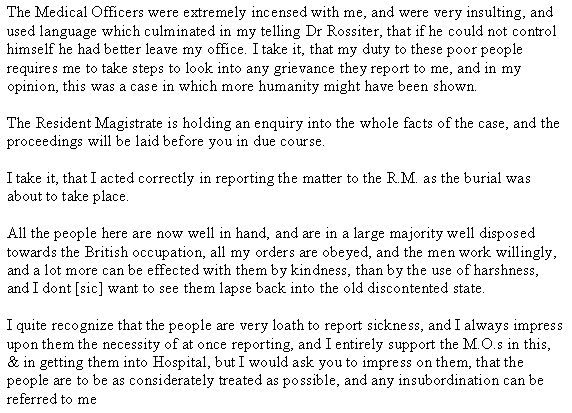 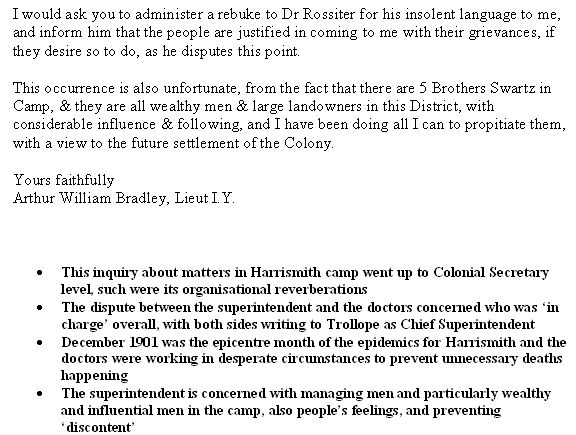
|
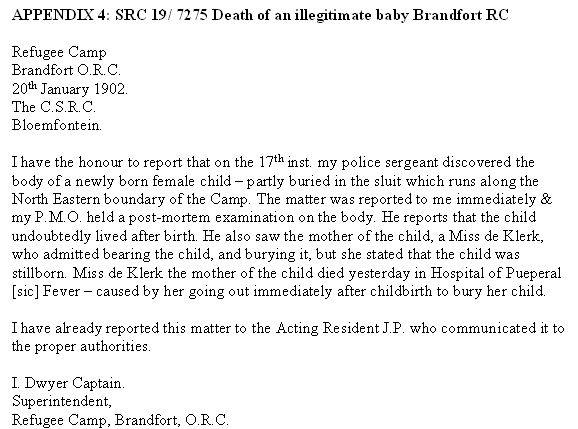 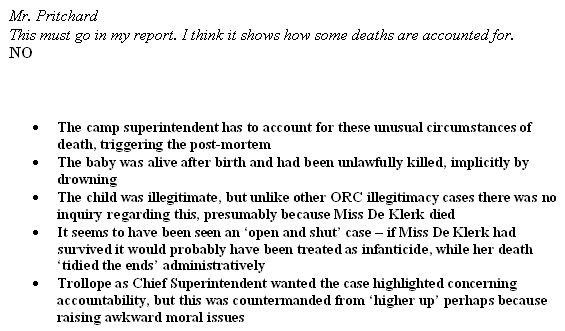
|
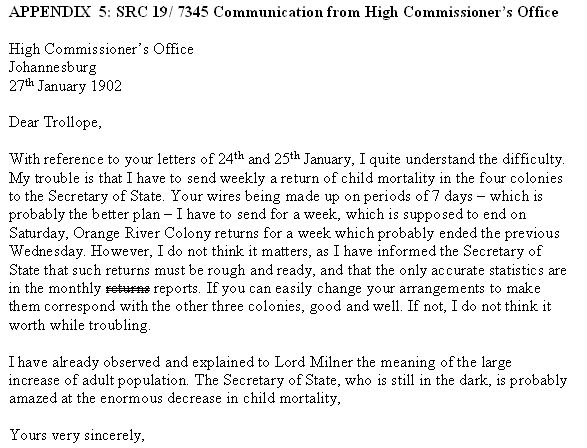 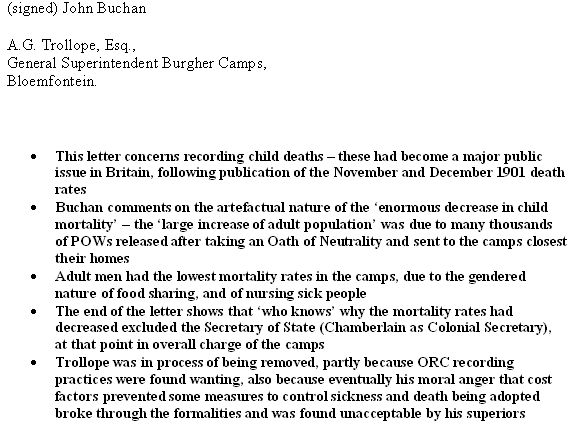
|
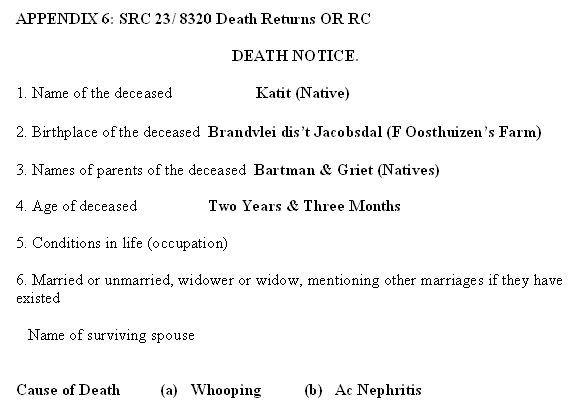 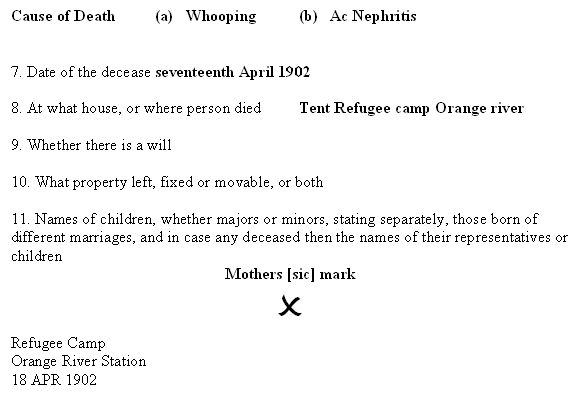 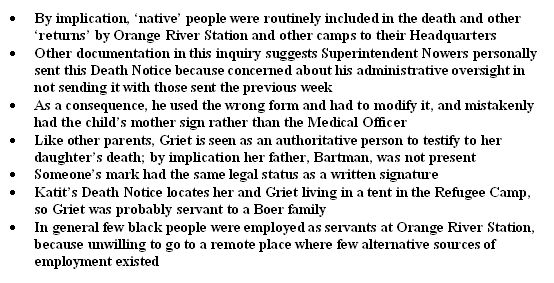
|
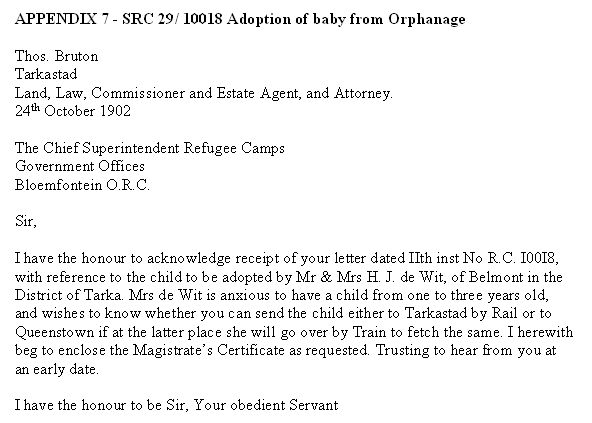 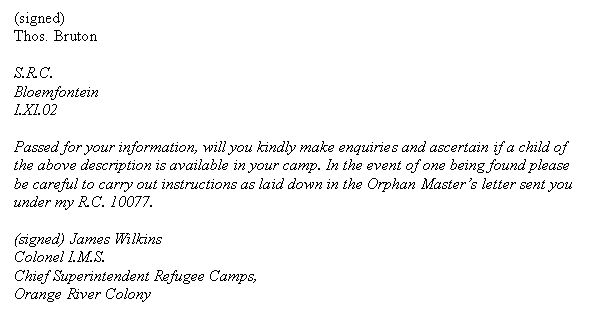 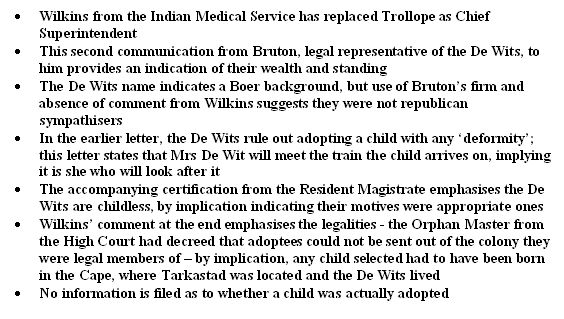
|
 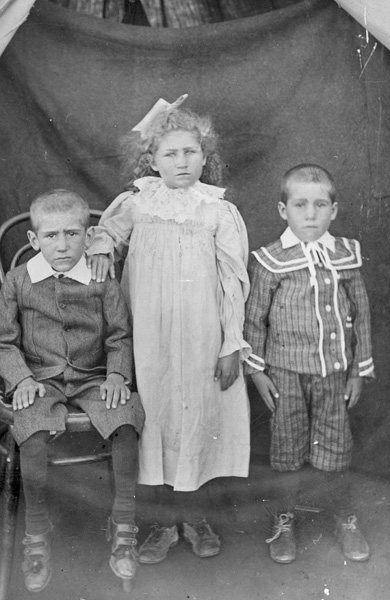 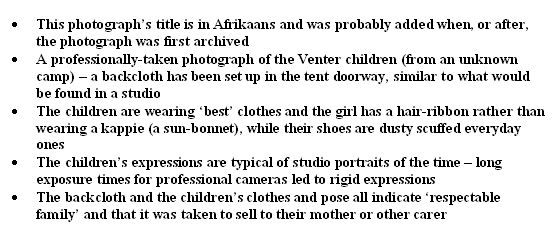
|
 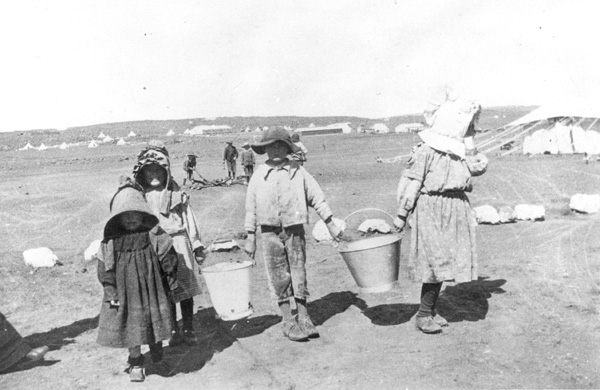 
|
 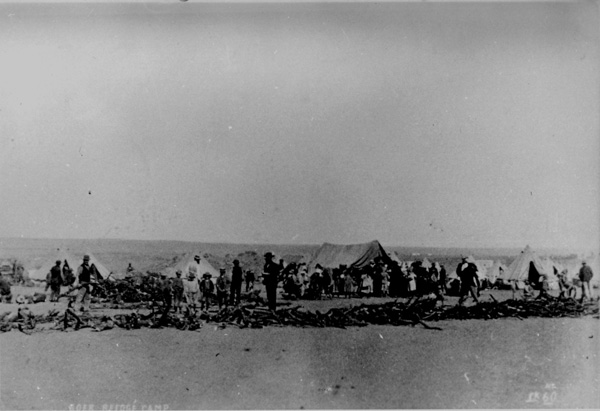 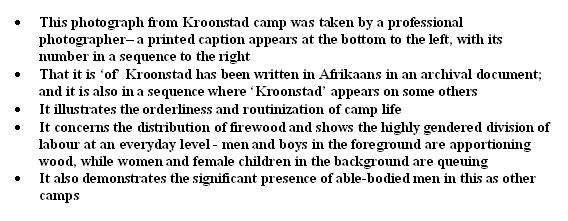
|
 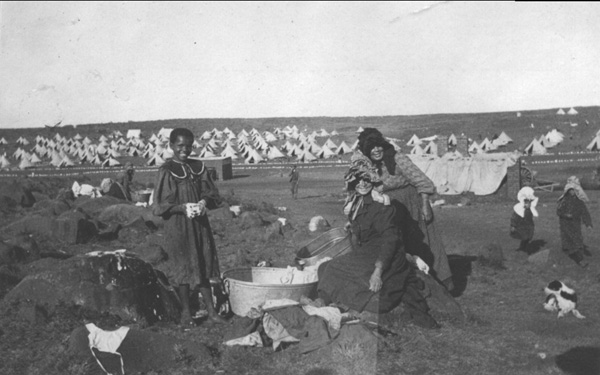 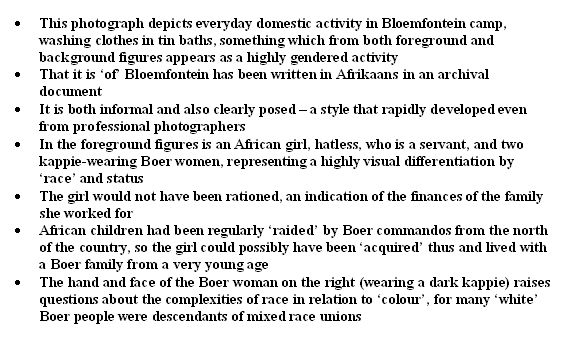
|
 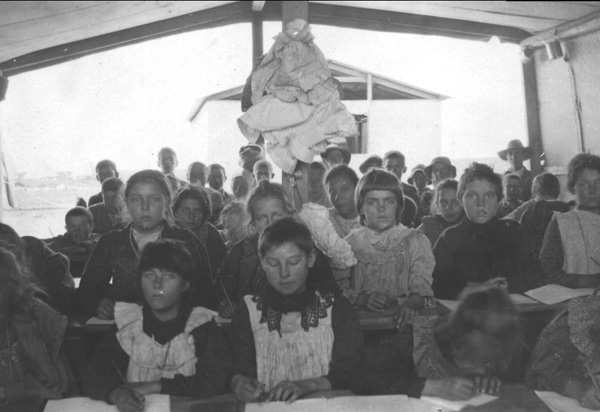 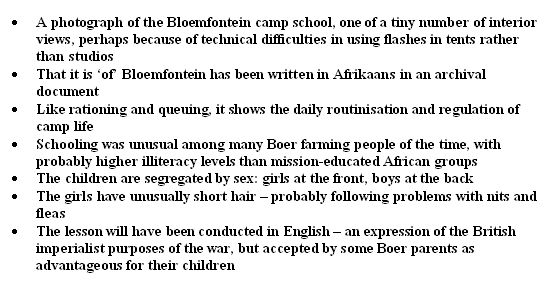
|
 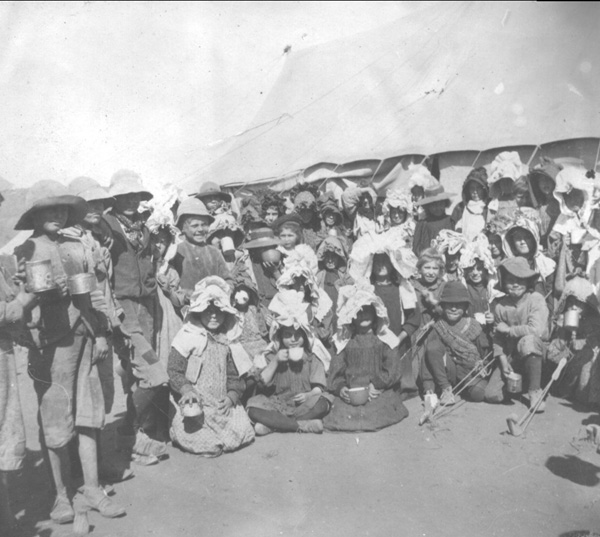 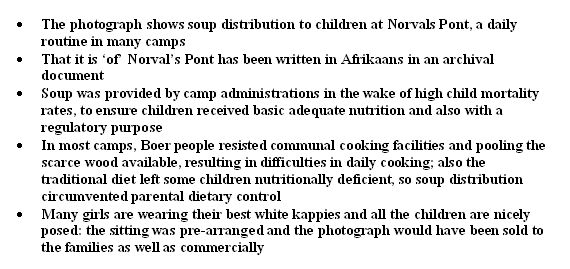
|
 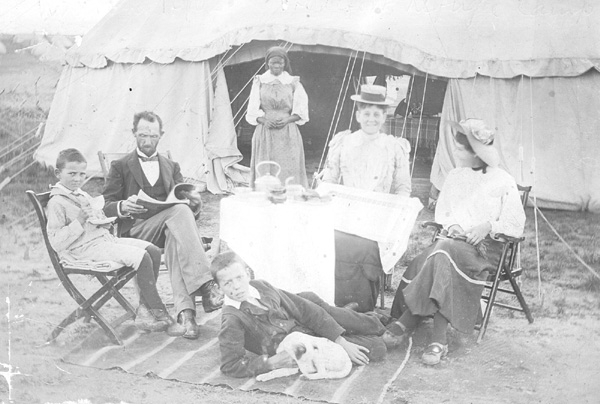 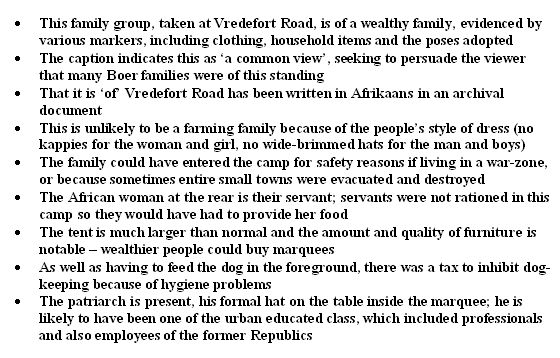
|
 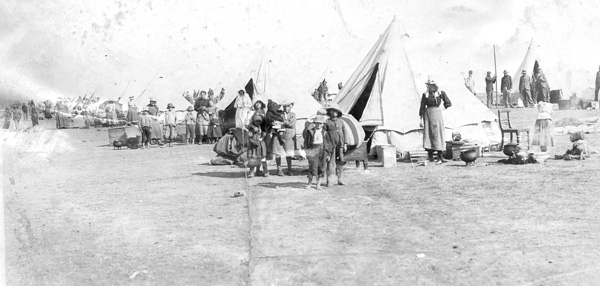 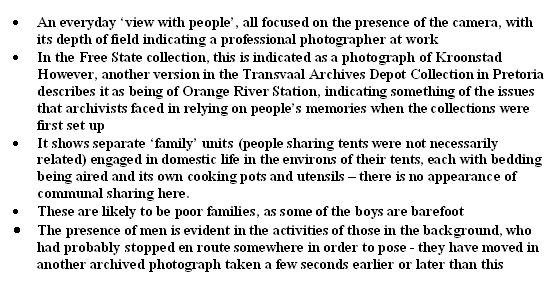
|
References
BALDWIN, Clive (2005) 'The narratively dispossessed: lessons for narrative theory and methods'. 5th Conference on 'Narrative, Memory & Knowledge', University of Huddersfield, April 2005.BANKS, Marcus (2001) Visual Methods in Social Research London: Sage Publications.
BARTEL, Diane (1996) Historic Preservation: Collective Memory and Historical Identity. New Brunswick, USA: Rutgers University Press.
BRINK, Cornelia (2000) 'Secular icons: looking at photographs from Nazi concentration camps', History and Memory 12: 135-50.
BUGIN, Victor ed. (1982) Thinking Photography. London: Macmillan.
CHAPLIN, Elizabeth (2005) 'The photograph in theory' Sociological Research Online 10, 1: <http://www.socresonline.org.uk/10/1/chaplin.html>.
CHRISTENSEN, Pia and James, Allison, eds. (2000) Research With Children: Perspectives and Practices. London: Falmer Press.
COHN, Bernard (1990) An Anthropologist Among the Historians and Other Essays. Delhi: Oxford University Press.
COHN, Bernard (1996) Colonialism and Its Forms of Knowledge: The British in India. Princeton: Princeton University Press.
CRAIS, Clifton (2002) The Politics of Evil: Magic, State Power, and the Political Imagination in South Africa. Cambridge: Cambridge University Press.
CUTHBERTSON, Greg, Grundlingh, Albert and Suttie, Mary-Lynn, eds. (2002) Writing A Wider War: Rethinking Gender, Race, and Identity in the South African War, 1899-1902. Cape Town: David Philip Publisher.
DAMPIER, Helen (2005a) 'Women's Personal Testimonies of the South African War Concentration Camps, 1899-1902 and After'. PhD thesis, University of Newcastle, UK.
DAMPIER, Helen (2005b) "Everyday Life' in Boer Women's Testimonies of the Concentration Camps of the South African War, 1899-1902", in Graeme Dunstall and Barry Godfrey, eds. Crime and Empire 1840-1940: Criminal Justice in Local and Global Context, pp. 202-23. Cullompton, UK: Willan Publishing.
DAMPIER, Helen and Stanley, Liz (2005) 'Simulacrum diaries: knowledge, the "moment of writing" and the diaries of Johanna Brandt-Van Warmelo'. 5th Conference on 'Narrative, Memory & Knowledge', University of Huddersfield, April 2005.
FERGUSON, Harry (2004) Protecting Children in Time: Child Abuse, Child Protection and the Consequences of Modernity. Basingstoke, UK: Palgrave Macmillan.
HANEKOM, Leandré and Wessels, Elria (2000) Valour, Thy Name Is Woman: An Overview of the Role of Afrikaner Women and Children Inside and Outside Anglo-Boer War Concentration Camps 1899–1902. Bloemfontein, South Africa: War Museum of the Boer Republics.
HENDRICK, Harry (1994) Child Welfare, England, 1872-1989. London: Routledge.
HENDRICK, Harry (2000) 'The child as social actor in historical sources: problems of identification and interpretation', in Pia Christensen and Allison James (eds.) Research With Children: Perspectives and Practices, pp.36-61. London: Falmer Press.
HOBHOUSE, Emily (1901) 'Report to the Committee of the Distress Fund for South African Women and Children'. London: South African Conciliation Committee Distress Fund, reprinted in A.W.G. Raath (1999) ed. The British Concentration Camps of the Anglo-Boer War 1899–1902: Reports on the Camps, pp. 35-117. Bloemfontein, South Africa: War Museum of the Boer Republics.
HOBHOUSE, Emily (1902) The Brunt of the War and Where It Fell. London: Methuen & Co.
HOBHOUSE, Emily (1923) Tant' Alie of the Transvaal, Her Diary 1880-1902. London: Allen & Unwin.
HOBHOUSE, Emily (1927) War Without Glamour. Women's War Experiences Written By Themselves, 1899-1902. Bloemfontein, South Africa: Nasionale Pers Beperk.
JACKSON, Stevi (1999) 'Feminist sociology and sociological feminism: recovering the social in feminist thought' Sociological Research Online 4, 3: http://www.socresonline.org.uk/4/3/jackson.html
JACKSON, Tabitha (1999) The Boer War. London: Channel 4 Books.
JAMES, Allison, Jenks, Chris and Prout, Alan (1998) Theorizing Childhood. Cambridge: Polity Press.
JAMES, Allison and Prout, Alan, eds. (1990) Constructing and Reconstructing Childhood. London: Falmer Press.
MCEWAN, Cheryl (2003) 'Building a postcolonial archive? Gender, collective memory and citizenship in post-apartheid South Africa', Journal of Southern African Studies 29: 739-57.
MAYNARD, Mary (1995) 'Beyond the "big three": the development of feminist theory in the 1990s' Women's History Review 4, 3, pp.259-81.
NASSON, Bill (1999) The South African War 1899-1902. London: Arnold.
PARIS, Heather (2003) '"Lifting up the little form": Victorian images of childhood and death 1870-1900', Sociological Research Online 8: http://www.socresonline.org.uk/8/3/paris.html
POLS, Robert (2002) Family Photographs 1860-1945. Richmond, UK: Public Record Office Publications.
PRETORIUS, Fransjohan ed. (2001) Scorched Earth. Cape Town: Human & Rousseau.
QVORTRUP, Jens, Bardy, M, Sgritta, G and Wintersberger, H, eds. (1994) Childhood Matters: Social Theory, Practice and Politics. Aldershot: Avebury.
RICHARDS, Thomas (1993) The Imperial Archive: Knowledge and the Fantasy of Empire. London: Verso.
RICHES, Gordon and Dawson, Pamela (1998) 'Lost children, living memories: the role of photographs in processes of grief and adjustment among bereaved parents', Death Studies 22: 121-40.
ROSE, Gillian (2000) 'Practising photography: an archive, a study, some photographs and a researcher', Journal of Historical Geography 24: 555-71.
ROSE, Gillian (2001) Visual Methodologies London: Sage Publications.
SONTAG, Susan (1977) On Photography. Harmondsworth: Penguin.
SONTAG, Susan (2003) Regarding the Pain of Others. New York: Picador.
SPIES, S.B. (1977) Methods of Barbarism: Roberts, Kitchener and Civilians in the Boer Republics January 1900–May 1902. Kaapstad, South Africa: Human and Rousseau.
SMITH, Dorothy (1974). 'Women's perspective as a radical critique of sociology' Sociological Quarterly 44: 7-13.
SMITH, Dorothy (1987). The Everyday World As Problematic: A Feminist Sociology. Buckingham: Open University Press.
SMITH, Dorothy (1990a). The Conceptual Practices of Power: A Feminist Sociology of Knowledge. Boston: Northeastern University Press.
SMITH, Dorothy (1990b). Texts, Facts and Femininity: Exploring the Relations of Ruling. London: Routledge.
SMITH, Dorothy (1999). Writing the Social: Critique, Theory, and Investigations. Toronto: University of Toronto Press.
SMITH, Dorothy (2005). Institutional Ethnography: A Sociology for People. California: AltaMira Press.
STANLEY, Liz (2002a) 'Women's South African War testimonies: remembering, forgetting and forgiving in Should We Forget?' Tydskrif vir Nederlands en Afrikaans (TN&A) 9: 93-118.
STANLEY, Liz (2002b) 'A "secret history" of local mourning: the South African War, the Vrouemonument and state commemoration' Society in Transition: Journal of the South African Sociological Association 19: 1-22.
STANLEY, Liz (2002c) 'Mourning becomes…: the work of feminism in the spaces between lives lived and lives written' Women's Studies International Forum 25: 1-17.
STANLEY, Liz (2004) 'Black labour and the concentration system of the South African War' Joernaal vir Eietdse Geskiedenis/Journal of Contemporary History 28: 190-213.
STANLEY, Liz (2005a) 'Emily Hobhouse, moral life and the concentration camps of the South African War, 1899-1902' South African Historical Journal.52: 60-81.
STANLEY, Liz (2005b, in press) 'Looking at the taciturn exterior: On legendary topography, the meta-narrative of commemoration and palimpsest monuments of the concentration camps of the South African War' Journal of Visual Culture.
STANLEY, Liz (2006, in press) Mourning Becomes… Post/Memory and the Concentration Camps of the South African War. Manchester: Manchester University Press; New Brunswick, USA: Rutgers University Press.
STANLEY, Liz and Dampier, Helen (2005) 'Aftermaths: Post/memory, commemoration and the concentration camps of the South African War 1899-1902' European Review of History, 12: 89-113.
STANLEY, Liz and Wise, Sue (1979) 'Feminist research, feminist consciousness and experiences of sexism', Women's Studies International Quarterly, 2: 259-74.
STANLEY, Liz and Wise, Sue (1983a) Breaking Out: Feminist Consciousness and Feminist Research. London: Routledge.
STANLEY, Liz and Wise, Sue (1983b) 'Back into the personal, our attempt to construct feminist research' in Gloria Bowles & Renate Duelli Klein, eds. Theories of Women's Studies, pp. 192-209. London: Routledge.
STANLEY, Liz and Wise, Sue (1990) 'Method, methodology and epistemology in feminist research processes', in Liz Stanley, ed. Feminist Praxis: Research, Theory and Epistemology in Feminist Sociology, pp.20-60. London: Routledge.
STANLEY, Liz and Wise, Sue (1992) 'Feminist epistemology and ontology', Indian Journal of Social Work 53: 343-65.
STANLEY, Liz and Wise, Sue (1993) Breaking Out Again: Feminist Ontology and Epistemology. London: Routledge.
STANLEY, Liz and Wise, Sue (2000) 'But the Empress has no clothes! Some awkward questions about the "missing revolution" in feminist theory', Feminist Theory 1: 261-88.
STANLEY, Liz and Wise, Sue (2006, in press) 'Commentary on putting feminist fractured foundationalism into practice in researching children in the concentration camps of the South African War' in (ed) Sharlene Hesse-Biber Sage Handbook on Feminist Research Methodology Thousand Oaks, USA: Sage Publications.
STARN, Randolph (2002) 'Truths in archives'. Common Knowledge 8: 387-401.
STRANGE, Julie-Marie (2002) '"She cried very little": death, grief and mourning in working-class culture, c. 1880-1914', Social History 27: 143-61.
THOMPSON, Edward Palmer (1963) The Making of the English Working Class. London: Gollantz.
VAN HEYNINGEN, Elizabeth (1999) 'The voices of women in the South African War', South African Historical Journal 41: 22-43.
VAN HEYNINGEN, Elizabeth (2001) 'British doctors versus Boer women: clash of medical cultures' in Fransjohan Pretorius, ed. Scorched Earth, pp. 178-97. Cape Town: Human & Rousseau.
VAN SCHOOR, M.C.E. (1970) Kampkinders Bloemfontein, South Africa: Oorlogsmuseum van die Boerrepublieke.
WALKER, Andre and Moulton, Rosalind (1989) 'Photo albums: images of time and reflections of self', Qualitative Sociology 12: 155-82.
WISE, Sue (1990) 'Becoming a feminist social worker', in Liz Stanley, ed. Feminist Praxis: Research, Theory and Epistemology in Feminist Sociology, pp. 236-49. London: Routledge.
WISE, Sue (1991) 'Child abuse: the NSPCC version', Feminist Praxis 32, University of Manchester, UK.
WISE, Sue (1995) 'Feminist ethics in practice', in Richard Hugman and David Smith,
eds. Ethical Issues in Social Work, pp. 104-19, London: Routledge.
WISE, Sue (1999) 'Reading Sara Scott's "Here be dragons"', Sociological Research Online 4: <http://www.socresonline.org.uk/4/1/wise.html>
WISE, Sue and Stanley, Liz (2003) 'Looking back and looking forward: some recent feminist sociology reviewed', Sociological Research Online 8: <http://www.socresonline.org.uk/8/3/wise.html>
WISE, Sue and Stanley, Liz (2005, in press) 'Having it all: feminist fractured foundationalism' in Kathy Davis, Mary Evans and Judith Lorber, eds. Handbook of Gender and Women's Studies. London: Sage Publications.

